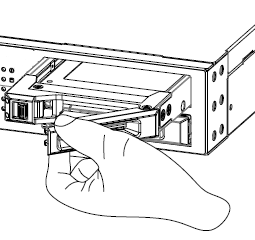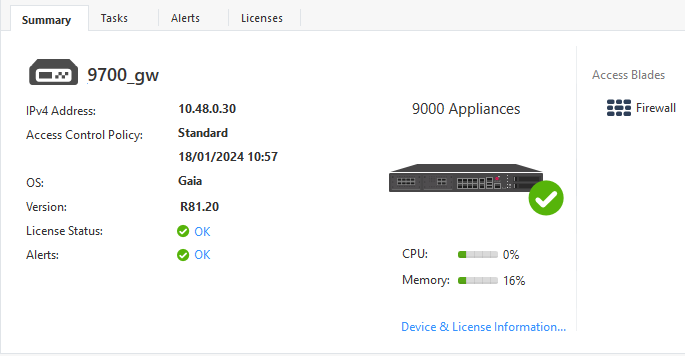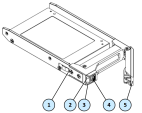9700 and 9800

|
|
Important - Make sure that you are electromagnetically grounded when you perform these procedures. ESD (electrostatic discharge) can damage the appliance. |
Removing a Storage Device
|
Item |
Description |
|---|---|
|
1 |
Storage device casing |
|
2 |
Power LED
|
|
3 |
Activity LED
|
|
4 |
Release latch |
|
5 |
Ejector handle |
To remove a storage device:
-
Push the release latch to the left.
The ejector handle pops out.
-
Hold the ejector handle and gently pull the storage device casing to remove the storage defrom the appliance.
|
|
Important - Be careful when you pull the ejector handle. If you pull too hard on the ejector handle, it can break off from the storage device casing. |
Installing a Storage Device
Insert the replacement storage device into the appliance.
To install a storage device:
-
Hold the storage device casing and insert the replacement storage device into the slot.
-
Push the ejector handle to close it.
The storage device clicks into position.
Synchronizing RAID
9700 and 9800 appliances support two storage devices.
By default, the 9700 Base and 9800 Base appliances are shipped with only one storage device.
For appliances with two storage devices, the appliance uses RAID1 mirroring across both storage devices. This lets the appliance continue to work if there is a storage device failure.
The appliance uses RAID1 mirroring across both storage devices. The mirror rebuild is automatic. Both storage devices must be the same type.
First Boot Up
At first boot up, wait for up to six hours to let the storage devices fully synchronize. If you reboot the appliance before the storage devices are synchronized, the synchronization starts again from the beginning at the next boot.
To monitor the RAID status of the storage devices from the CLI:
-
Log in to the appliance and open a command line.
-
Run:
raid_diagnosticThis shows data about the RAID and storage devices, with the percent of synchronization completed.
DiskID 0is the top storage device.DiskID 1is the bottom storage device.When you first turn on the appliance, the RAID state (in the VolumeID line) shows
DEGRADED(this indicates that the drives are not synchronized). The DiskID:0 state showsONLINEand the DiskID:1 state showsINITIALIZING.After the RAID is synchronized, the RAID state (in the VolumeID line) shows
OPTIMAL(this indicates that the drives are synchronized). The DiskID:0 and DiskID:1 states showONLINE.
To monitor the RAID status of the storage devices from the Gaia Portal:
-
Log in to the Gaia Portal.
-
From the left tree, click Maintenance > RAID Monitoring.
To monitor the RAID status of the storage devices from SmartConsole:
-
From Gateways & Servers, select the object that represents the appliance.
-
In the Summary tab, click Device & License Information.

-
Scroll to the end of the window and click RAID Volumes.
The window shows volume and disk information.

To monitor the RAID status of the storage devices using SNMP:
Set up SNMP traps to send information about the RAID.
Use OID: 1.3.6.1.4.1.2620.1.6.7.7
For more about how to configure the SNMP settings on the appliance, see the Gaia Administration Guide for your version.
To hot swap a storage device:
|
|
Important - Make sure that there is at least one fully synchronized storage device in the system. |
-
When the system is up, remove the failed storage device.
-
Wait 15 seconds.
The appliance recognizes that you removed a storage device.
-
Insert a new storage device. If necessary, you can reboot the appliance with one storage device and install the new storage device later.
The system automatically adds the new storage device to the RAID configuration.



